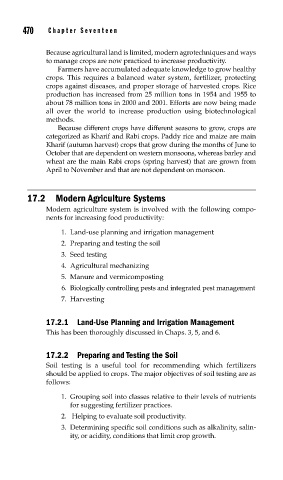Page 498 - Biosystems Engineering
P. 498
470 Cha pte r Se v e ntee n
Because agricultural land is limited, modern agrotechniques and ways
to manage crops are now practiced to increase productivity.
Farmers have accumulated adequate knowledge to grow healthy
crops. This requires a balanced water system, fertilizer, protecting
crops against diseases, and proper storage of harvested crops. Rice
production has increased from 25 million tons in 1954 and 1955 to
about 78 million tons in 2000 and 2001. Efforts are now being made
all over the world to increase production using biotechnological
methods.
Because different crops have different seasons to grow, crops are
categorized as Kharif and Rabi crops. Paddy rice and maize are main
Kharif (autumn harvest) crops that grow during the months of June to
October that are dependent on western monsoons, whereas barley and
wheat are the main Rabi crops (spring harvest) that are grown from
April to November and that are not dependent on monsoon.
17.2 Modern Agriculture Systems
Modern agriculture system is involved with the following compo-
nents for increasing food productivity:
1. Land-use planning and irrigation management
2. Preparing and testing the soil
3. Seed testing
4. Agricultural mechanizing
5. Manure and vermicomposting
6. Biologically controlling pests and integrated pest management
7. Harvesting
17.2.1 Land-Use Planning and Irrigation Management
This has been thoroughly discussed in Chaps. 3, 5, and 6.
17.2.2 Preparing and Testing the Soil
Soil testing is a useful tool for recommending which fertilizers
should be applied to crops. The major objectives of soil testing are as
follows:
1. Grouping soil into classes relative to their levels of nutrients
for suggesting fertilizer practices.
2. Helping to evaluate soil productivity.
3. Determining specific soil conditions such as alkalinity, salin-
ity, or acidity, conditions that limit crop growth.

